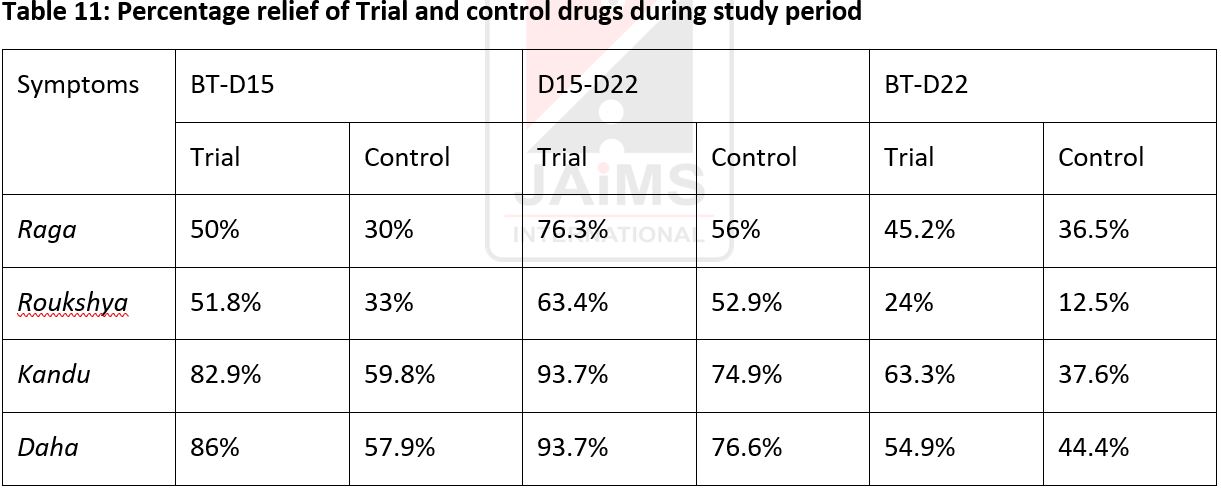A Comparative Clinical Trial on Harenvadi Churna Lepa versus Yashtimadhu Churna Lepa with Vilvadi Agada as common internal medicine in Kshalana Visha with special reference to Detergent dermatitis
DOI:
https://doi.org/10.21760/jaims.10.3.9Keywords:
Kshalana Visha, Detergent dermatitis, Harenvadi Curna, Yashtimadhu Curna, Lepa, Agada TantraAbstract
Introduction: Detergents are used in almost every household in developed and developing countries. The resulting dermatitis occurs mainly on the hands, is caused by irritation from cleaning agents, and is highly stressful and debilitating. The main objective of the study was to evaluate the comparative effect of Harenvadi Curna Lepa with Yashtimadhu Curna Lepa in reducing Four cardinal features of Kshalana Visha, viz. Erythema, Dryness, Pruritus and Burning sensation. Harenvadi Curna Lepa mentioned in Aṣṭanga Samgraha Visha Pratiṣedha Adhyāya, contains 4 drugs, each having Vishahara property and specially indicated in Garopahatha Tvacha. Methods: The study was a comparative clinical trial involving 86 participants diagnosed with detergent dermatitis, randomly allocated in to trial and control groups. Trial group recieved Harenvadi Curna and the control group received Yashtimadhu Curna. Both groups received Vilwadi Agada as the common internal medicine. Assessment were done before treatment, 8th, 15th and 22nd day (follow-up). Result: Result concluded that trial drug was more efficacious than control drug in managing 4 cardinal symptoms of Kshalana Visha (p<0.001). Discussion: There is significantly superior difference in the efficacy of Harenvadi Curna Lepa when compared to Yashtimadhu Curna as Lepa in the management of Kshalana Visha w.s.r. to Detergent dermatitis.
Downloads
References
Antonov Dimitar, Schlieman Sibylle, Elsner Peter. Hand dermatitis: A review of clinical features, prevention and treatment. Am J Clin Dermatol. 2015;16:257-270. doi: 10.1007/s40257-015-0130-z.
Austoria AJ, Lakshmi C, Srinivas CR, Anand CV, Mathew AC. Irritancy potential of 17 detergents used commonly by the Indian household. Indian J Dermatol Venereol Leprol. 2010 May-Jun;76(3):249-53.
Kunte Anna Moreswar. Ashtanga Hrudaya [Sarvangasundara-Arunadutta, Ayurvedarasayana-Hemadri commentary, Sanskrit]. Varanasi: Chowkhamba Krishnadas Academy; Ayurveda series. Uttarasthana 35/5-6. p. 902-903.
Acharya Trikamji Jadavji. Charaka Samhita [Ayurveda Dipika-Chakrapanidutt commentary, Sanskrit]. 2nd ed. Varanasi: Choukhamba Krishnadas Academy; Ayurveda series; 2009. p. 702-703. Chikitsa Sthana-23/14.
Acharya Trikamji Jadavji. Susrutha Samhitha [Nibandhasamgraha-Dalhana, Nyayachandrika Panjika-Sri Gayadasa commentary on Nidanasthana, Sanskrit]. Reprint 2008. Varanasi: Choukhamba Krishnadas Academy; Kalpasthhana-1/24-2751. ISBN: 81-218-0011-0.
Sharma Shivaprasad. Vaghbhatavirachitha Ashtanga Samgraham with Sasilekha Sanskrit commentary. Varanasi: Chaukhambha Sanskrit series; Reprint 2016. p. 205-206.
Vaidya Vachaspathi. Madhava Nidana with Madhukosavyakhyana, Vijayarakshitha and Sreekandadutta. Varanasi: Chaukhambha Orientalia; p. 316-317.
Tewari PV. Kasyapa Samhitha or Vridhajivakiya Tantra. Haridas Ayurveda series. Chaukhambha Viswabharati Academy; 2008. p. 311-314.
Hemmati M, Ghasemzadeh A, Haji Malek-kheili M, Khoshnevisan K, Koohi M. Investigation of acute dermal irritation/corrosion, acute inhalation toxicity, and cytotoxicity tests for Nanobiocide®. Nanomed Res J. 2016;1(1):23-29.
Simion FA, Abrutyn ES, Draelos ZD. Ability of moisturizers to reduce dry skin and irritation and to prevent their return. J Cosmet Sci. 2005 Nov-Dec;56(6):427-44.
Åström M, Thet Lwin ZM, Teni FS, et al. Use of the visual analogue scale for health state valuation: a scoping review. Qual Life Res. 2023;32:2719–2729.
Hegde PL, Harini A, editors. A Textbook of Dravyaguna Vijnana. Reprint edition. Varanasi: Chaukambha Publications; 2015.
Klein G, Grubauer G, Fritsch P. The influence of daily dish-washing with synthetic detergent on human skin. Br J Dermatol. 1992;127:131-7.
Agarwal US, Besarwal RK, Gupta R, Agarwal P, Napalia S. Hand eczema. Indian J Dermatol. 2014 May;59(3):213-24.
Petersen AH, Johansen JD, Hald M. Winter season, frequent hand washing, and irritant patch test reactions to detergents are associated with hand dermatitis in health care workers. Contact Dermatitis. 2014 Jan;70(1):28-35.
Suwarna Umarkar V, Deepak Vyas M, Sheela Kulkarni B, Kalpana Sathe D. Variation in skin hydration on the basis of Deha Prakriti (body constitution): A cross-sectional observational study. AYU. 2018 Jul–Sep;39(3):127-131.















